Cobra Identification & Info
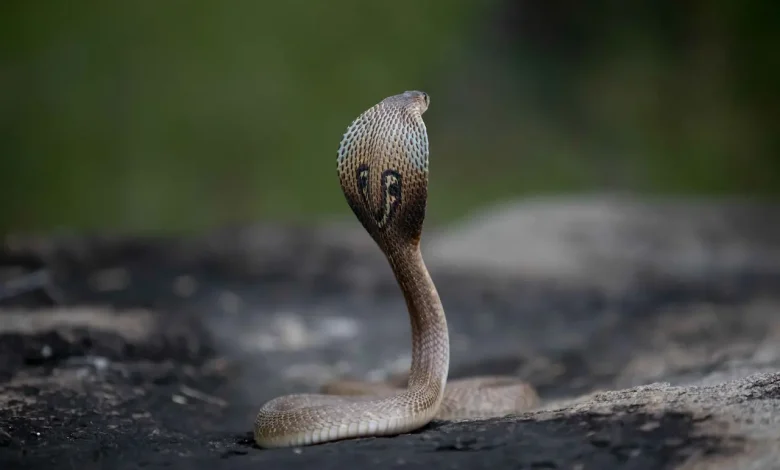


Cobra Identification
Monocled Cobras (Naja kaouthia)
Monocled cobra bites are very dangerous and a bite can be potentially deadly. These cobras have caused many deaths in Thailand over the years, despite good antivenin. The venom affects nerves and blocks their ability to send nerve impulses, which can result in death when the diaphragm cannot function.
DANGER: 5/5 – Extremely dangerous
VENOM POTENCY: Extremely strong.
VENOM DELIVERY SYSTEM: Very good. Well-developed, though short and efficient hollow fangs in the front of the mouth.
BITE FREQUENCY: Very high.
LENGTH: Up to 2 meters (6 feet 7 inches).
GIRTH: Up to forearm thickness (28 cm or 11 inches circumference).
RANGE: Found all over Thailand.
ACTIVE PERIOD: This snake can be found active during daylight and after dark on the ground.
FREQUENCY FOUND: Found often as they tend to be in residential areas where they eat rodents, toads, frogs, fish, and snakes.
THREAT DISPLAY: Cobras typically flatten their necks and raise their heads off the ground as shown in the images above. It is a myth that they cannot bite without having hooded first. They strike by thrusting the head forward and down, or nearly horizontal.
These cobras may make a distinctive hissing sound.
This snake bites quickly and with or without provocation. It will bite when cornered or in close proximity. If trapped (cornered) with the only escape route being through your legs, or right beside you, this snake may bite as it passes by – without a hood being shown first. If you step on this snake, it is very likely to bite.
Much more active and easily aggravated as temperatures get warmer than 33° C (91° F).
KEYs To IDENTIFICATION:
1.) May form a hood with the neck (flattened).
2.) Can hiss by forcing air out of the small space in the mouth.
3.) An eye or monocle shape is usually present on the back of the hood.
SIMILAR VENOMOUS SPECIES: The next two snakes – Thai Spitting Cobra (N. siamensis) and the Equatorial Spitting Cobra (N. sumatrana) can look very similar.
VENOM TYPE: Neurotoxic (nerve damaging) and necrotoxic venom causing skin and muscle destruction primarily.
SYMPTOMS OF ENVENOMATION: Around the bite site there may be pain, swelling, bruising, blistering, and moderate to severe necrosis (tissue destruction). There may also be headaches, nausea, vomiting, abdominal pain, diarrhea, dizziness, unconsciousness, or convulsions.
ANTIVENIN: Cobra antivenin from the Queen Saovabha Memorial Institute, Bangkok, Thailand. Phone: +66 2 252 0161 (0162, 0163, 0164)
Most large public and private hospitals in Thailand will have this antivenom on-hand or can obtain it quickly.
Monocled Cobra IMMEDIATE FIRST AID
Click here for instructions.
If venom from this snake has contacted your eye(s) follow directions here.
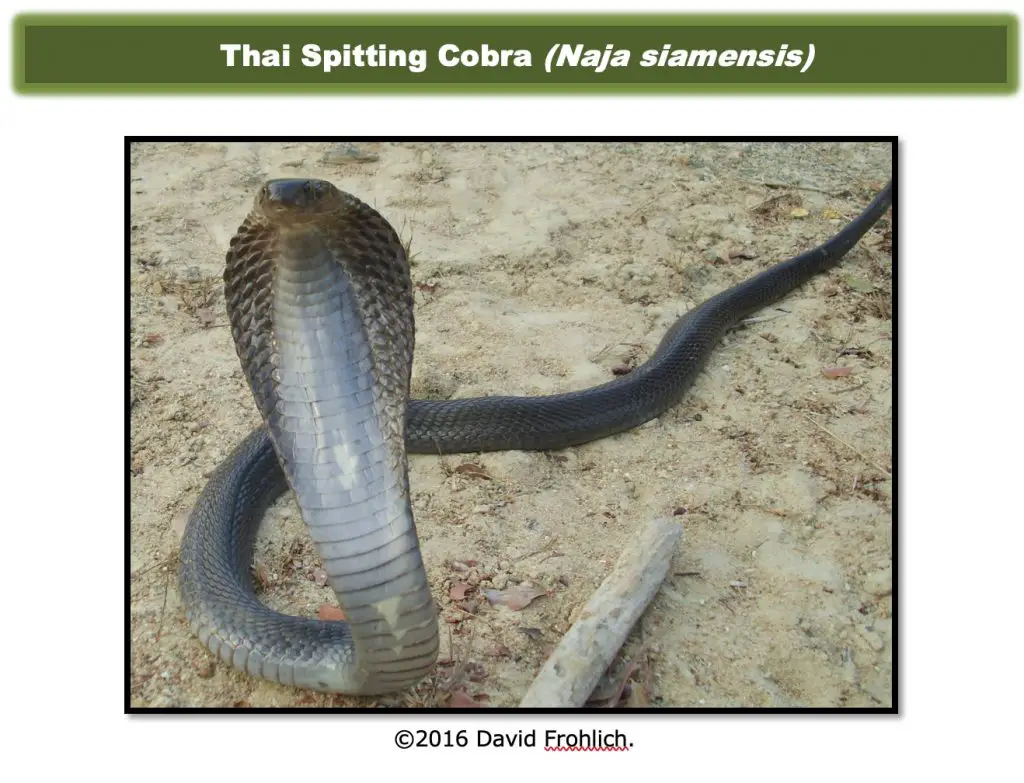
Thai Spitting Cobra (Naja siamensis)
Thai spitting cobras are very dangerous and a bite is potentially deadly. These cobras have caused numerous deaths in Thailand over the years. This snake is active at night and preys on rodents. Like the other two cobras in the Naja genus, this snake tends to become very easily aggravated as the temperature rises above 33° C (91° F).
DANGER: 5/5 – Extremely dangerous
VENOM POTENCY: Extremely strong.
VENOM DELIVERY SYSTEM: Very good. Well-developed, though short fangs, in the front of the mouth. This cobra is also capable of spraying venom at attackers in a fine mist. Their accuracy is excellent, and they can hit human eyes from two to three meters away.
BITE FREQUENCY: Very high.
LENGTH: Up to 1.6 meters (5 feet 3 inches).
GIRTH: Up to forearm thickness (28 cm or 11 inches circumference).
RANGE: Across Thailand north, west, and east of Bangkok.
ACTIVE PERIOD: Primarily nocturnal and active on the ground.
FREQUENCY FOUND: Rare.
THREAT DISPLAY: Cobras typically flatten their necks and raise their heads off the ground. They strike by thrusting the head forward and usually down.
This is one of the two spitting cobras in the country. They can easily and repeatedly spray a fine mist of venom 2 – 3 meters toward your face – with, or without provocation. The venom is the same that affects you during a bite. If your eyes are sprayed with venom, rinse them constantly for 15-30 minutes. Go to a hospital to have them checked because damage can result – even blindness. This is one reason it is essential to have clean water with you while walking through Thailand’s rainforest.
If trapped (cornered) with the only escape route being through your legs, or right beside you, it may bite as it passes by – without a hood being shown first. If you step on this snake, the same behavior can be expected.
These cobras can make a distinctive hissing sound.
Keys To IDENTIFICATION:
1.) This snake may have a monocle, U, V, or H shape on the back of the neck (hood).
2.) If the snake hoods and spits, it is likely one of the two spitting cobras.
SIMILAR VENOMOUS SPECIES: Monocled Cobra (N. kaouthia) and the Equatorial Spitting Cobra (N. sumatrana) can look very similar.
VENOM TYPE: Neurotoxic (nerve damaging) and necrotoxic venom which causes skin and muscle destruction primarily.
SYMPTOMS OF ENVENOMATION: Around the bite site there may be pain, swelling, bruising, blistering, and moderate to severe necrosis (tissue destruction). There may also be headaches, nausea, vomiting, abdominal pain, diarrhea, dizziness, unconsciousness, or convulsions.
Antivenom: No specific antivenom in Thailand exists for this snake. Hospital staff will treat symptoms. The Naja kaouthia specific antivenom is thought to be somewhat effective in treating bites from Naja siamensis. Info below.
Cobra antivenin from the Queen Saovabha Memorial Institute, Bangkok, Thailand. Phone: +66 2 252 0161 (0162, 0163, 0164)
Most large public and private hospitals in Thailand will have this antivenin on-hand or can obtain it quickly.
THAI SPITTING COBRA IMMEDIATE FIRST AID
Click here for instructions.
If venom from this snake has contacted your eye(s) follow directions here.
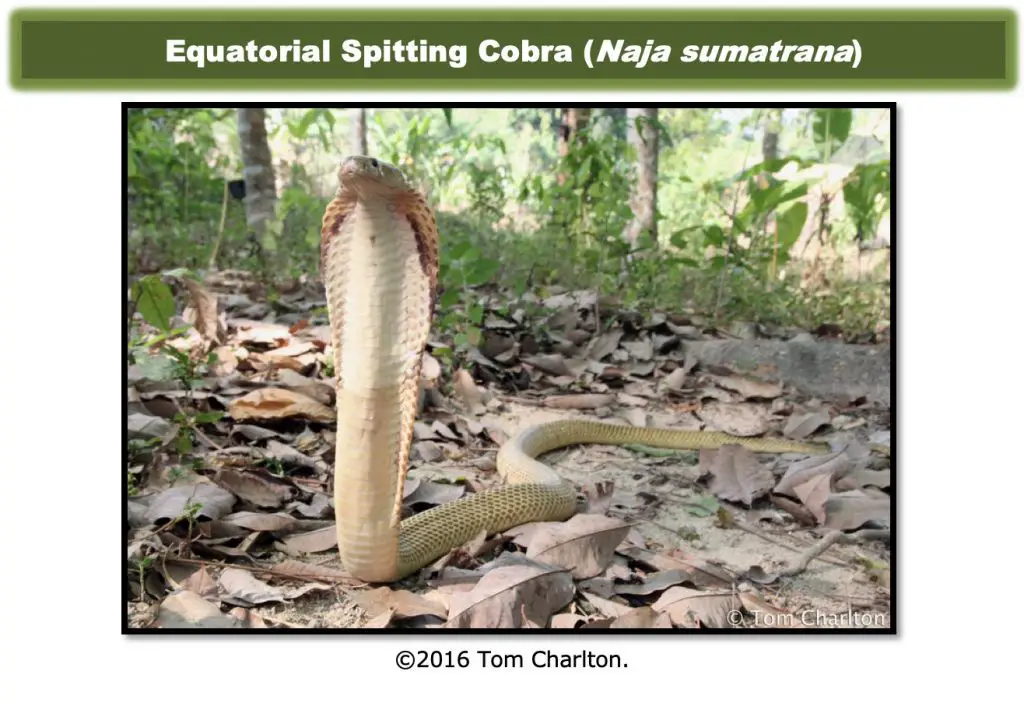
Equatorial Spitting Cobra (Naja sumatrana)
Equatorial spitting cobras are very dangerous and a bite is potentially deadly. These cobras have caused deaths in Thailand. This snake, like the other two cobras in the Naja genus tend to become very easily aggravated as temperature goes above 33° C (91° F). Their venom is necrotic – destroying tissue, and neurotoxic – affecting the ability of the muscles to send nerve impulses.
DANGER: 5/5 – Extremely dangerous.
VENOM POTENCY: Extremely strong.
VENOM DELIVERY SYSTEM: Very good. Well-developed, though short fangs in the front of the mouth. This cobra is also capable of spraying venom at attackers in a fine mist. Their accuracy is excellent, and they can hit your eyes from two to three meters away.
BITE FREQUENCY: Very high.
LENGTH: Up to 1.6 meters (5 feet 3 inches).
GIRTH: Up to forearm thickness (28 cm or 11 inches circumference).
RANGE: Southern Thailand.
ACTIVE PERIOD: Mostly active at night on the ground.
FREQUENCY FOUND: Rare.
THREAT DISPLAY: Cobras typically flatten their necks and raise their heads off the ground. They strike by thrusting the head forward and usually down.
This is one of the two spitting cobras in the country. They can easily and repeatedly spray a fine mist of venom 2 – 3 meters toward your face – with, or without provocation. The venom is the same that affects you during a bite. If your eyes are sprayed with venom, rinse them constantly for 15-30 minutes. Go to a hospital to have them checked because damage can result – even blindness. This is one reason it is essential to have clean water with you while walking through Thailand’s rainforest.
If trapped (cornered) with the only escape route being through your legs, or right beside you, it may bite as it passes by – without a hood being shown first. If you step on this snake, the same behavior can be expected.
These cobras can make a distinctive hissing sound.
KEYs To IDENTIFICATION:
1.) Occurs in yellow or black phases.
2.) No mark on the back of the neck (hood).
3.) Black form may have yellow bands, spots, or eye-shaped marks.
SIMILAR VENOMOUS SPECIES: Monocled Cobra (N. kaouthia) and the Siamese Spitting Cobra (N. siamensis) can look very similar.
VENOM TYPE: Neurotoxic (nerve damaging) and necrotoxic (causing skin and muscle destruction primarily) venom.
SYMPTOMS OF ENVENOMATION: Around the bite site there may be pain, swelling, bruising, blistering, and moderate to severe necrosis (tissue destruction). There may also be headaches, nausea, vomiting, abdominal pain, diarrhea, dizziness, unconsciousness, or convulsions.
ANTIVENIN: No specific antivenom in Thailand exists for this snake. Hospital staff will treat symptoms.
Equatorial SPITTING COBRA IMMEDIATE FIRST AID
Click here for instructions.
If venom from this snake has contacted your eye(s) follow directions here.
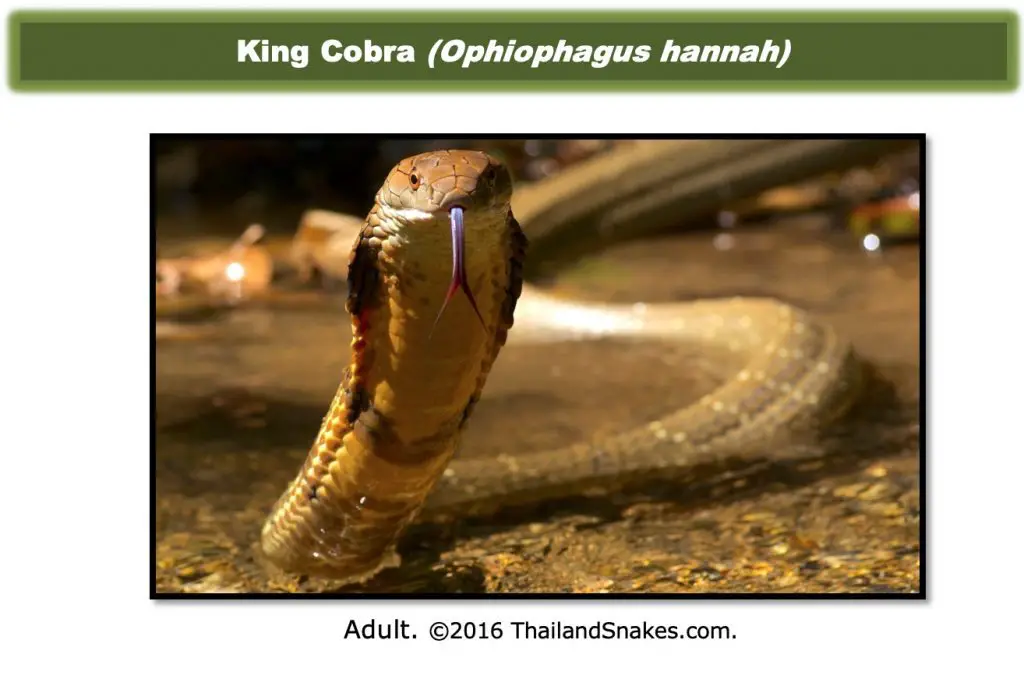
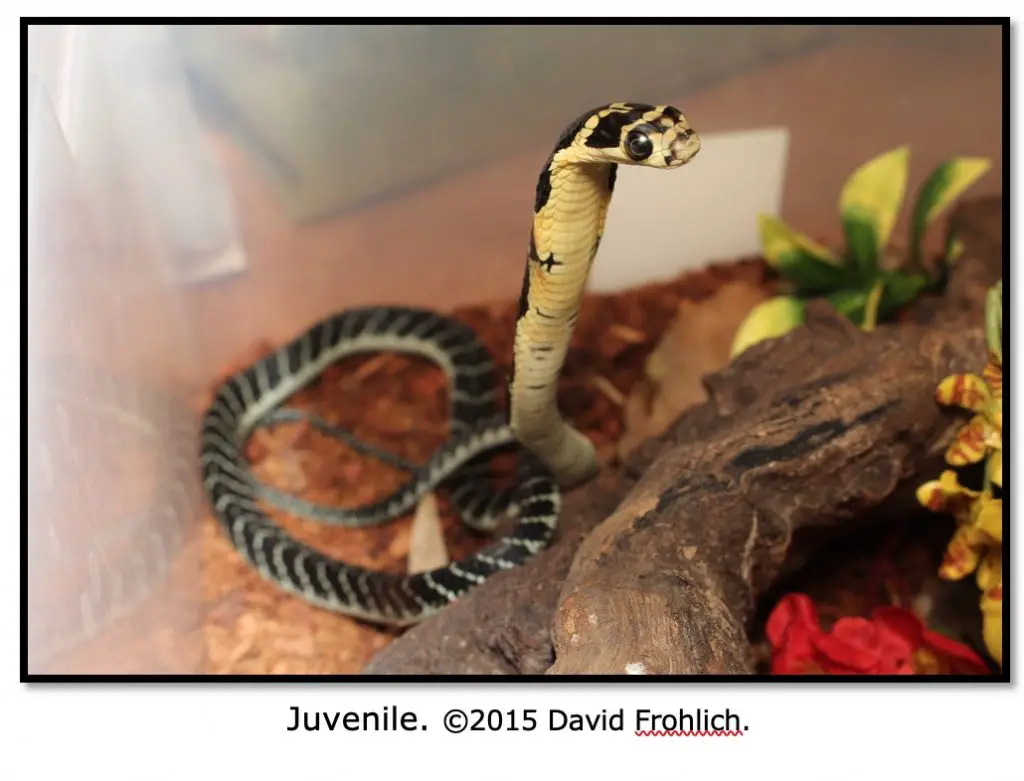
King Cobra (Ophiophagus hannah)
King cobras are not commonly seen, but they are very dangerous if you get too close. This is the longest venomous snake in the world. The power of the venom lies not in its potency, though it is quite strong, the combination of venom strength and quantity is enough to kill elephants. King cobra bites are very dangerous and a bite is potentially deadly for humans. The king cobra has caused many deaths in Thailand over the years. Younger king cobras under 3 meters long are exceptionally fast, agile, and unpredictable. Kings appear to be fearless and will come within a few meters of humans without fear. This snake bites when provoked, cornered, or in close proximity. Like other cobras, the king does not need to show a hood before it can bite.
DANGER: 5/5 – Extremely dangerous.
VENOM POTENCY: Very strong.
VENOM DELIVERY SYSTEM: Very well-developed, though short fangs in the front of the mouth, and a very large volume of venom.
BITE FREQUENCY: High.
LENGTH: Up to 5.85 meters (19 feet 3 inches).
GIRTH: Up to human thigh thickness (51 cm or 20 inches circumference).
RANGE: Across Thailand.
ACTIVE PERIOD: Active during the day on the ground, and sometimes in the very early evening as they find a tree to rest in for the night.
FREQUENCY FOUND: Very rare.
THREAT DISPLAY: King cobras also flatten at the neck and raise their head off the ground in a defensive stance when alarmed. Large kings can raise up more than a meter high. The higher they raise their heads, the more reach they will have as they strike, falling straight forward the same as the other cobras do while striking.
The king cobra is one of the few snakes that can appear to be coming after you when it strikes. This snake does, at times, move its entire body forward as it strikes, and if it misses, it can still be moving forward for a follow-up strike. Kings are really dangerous when they’re aggravated because the distance they can cover to reach you is great.
Kings sometimes allow humans to get very close before they become alarmed.
KEYS TO IDENTIFICATION:
1.) Length can be one identifying feature. If the snake is a cobra (hooded) and 3 meters or larger, it is definitely a king cobra.
2.) Variable color – solid black, olive green, or brown, black or brown or yellow or tan or olive green with thin light colored bands.
3.) Juveniles are dark with light chevrons across the entire body and on top of the head.
VENOM TYPE: Neurotoxic.
SYMPTOMS OF ENVENOMATION: Around the bite site there may be pain, swelling, bruising, blistering, and moderate to severe necrosis (tissue destruction). There may also be headache, nausea, vomiting, abdominal pain, diarrhea, dizziness, unconsciousness, or convulsions
ANTIVENIN: King Cobra Antivenin from Queen Saovabha Memorial Institute, Bangkok, Thailand. Phone: +66 2 252 0161 (0162, 0163, 0164). Most large public and private hospitals in Thailand will have this antivenom on-hand or can obtain it quickly.
King COBRA IMMEDIATE FIRST AID
Wrap bites from this snake immediately. Click here for more complete instructions.
